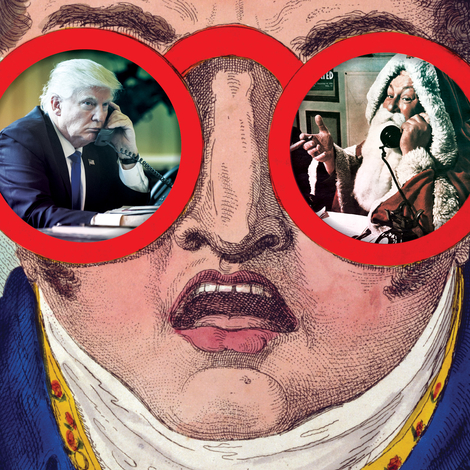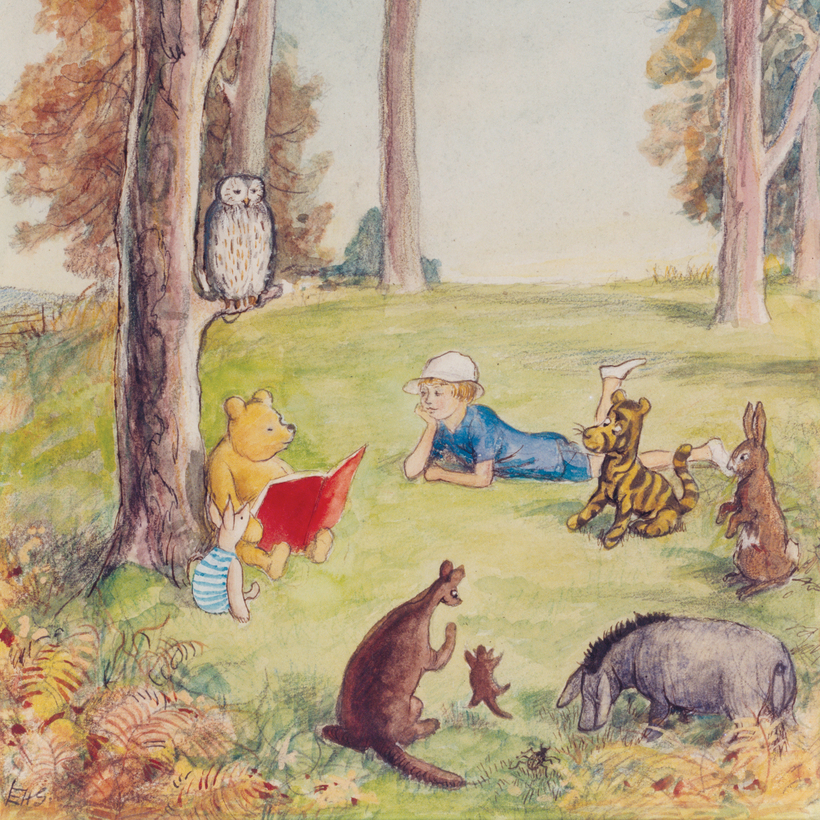Alan Alexander Milne (“A.A.” to you, me, and the rest of the world) wrote just four books for children, but what a quartet: his pair of verse collections, When We Were Very Young (1924) and Now We Are Six (1927), and those two comparative volumes, Winnie-the-Pooh (1926) and The House at Pooh Corner (1928). All four were instant best-sellers on both sides of the Atlantic, beloved by kids and adults alike, as they remain to this day. I should confess right away that I have personally wept more than once at the ending of Pooh’s saga, in which he is banished to an uncomprehending limbo while his playmate, Christopher Robin, is shipped off to boarding school—the putting away of childish things and all that. It’s become sort of a literary party trick for me, the crying, almost Pavlovian but no less sincere.
The love isn’t universal. One early dissenter was Dorothy Parker, who panned the final book in her Constant Reader column for The New Yorker. She objected to Pooh’s coinage of the term “hummy” (something akin to hummable, but twee-er). As she famously wrote, “And it is that word ‘hummy,’ my darlings, that marks the first place in The House at Pooh Corner at which Tonstant Weader fwowed up.”

No matter. As the same magazine reported seven years later, in a rather alarmed look at the then nascent character-licensing business:
“The likeness of Winnie-the-Pooh is obtainable on spoons and knives and forks, on chinaware, on jars of honey (spelled ‘hunny,’ of course), on soap, on bibs, dresses, suits, coats, and hats, on picture puzzles, on nursery games, on modeling-clay sets, on pencils, erasers, bookstraps, and bookends … ” And on and on and on. Citing “reliable sources,” the magazine concluded that “Mr. Milne makes more money now from manufacturers than he does from publishers.”
And that was three whole decades before Walt Disney got his hands on the silly old bear, followed by Loggins and Messina (singers of the 1971 Top 40 single “House at Pooh Corner”), Benjamin Hoff (author of the 1982 best-seller The Tao of Pooh), and Rhys Frake-Waterfield (writer, director, and producer, of the 2023 film Winnie-the-Pooh: Blood and Honey, a quickie slasher film enabled by Pooh’s having entered the public domain in the U.S. that same year). Tonstant Weader has had so many weasons to fwow up.

And yet all of that success and whimsical muscle would prove a burden, maybe even a curse, for two of the three men most closely involved, an irony detailed in The Making of Winnie-the-Pooh: Pooh, Piglet, Eeyore, and Other Beloved Characters. While none of this is uncharted territory, the new book stakes a claim as the first dual biography of Milne and Ernest Howard (“E.H.”) Shepard, the illustrator who brought all those beloved characters to life. Another selling point: the author is James Campbell, who is Shepard’s great-grandson-in-law and happens to manage the illustrator’s estate, meaning the new book is rich with art, including previously unpublished sketches and family photos—Milne’s as well as Shepard’s. It’s an affectionate, breezy read, but not an un-cloudy one.
Both men were products of the late Victorian era. Milne, born in 1882, was the third son of a London schoolmaster. Shepard, three years older, grew up in London as well; his father was an architect.
Milne would achieve literary renown early on, editing the college magazine The Granta at Cambridge (the forerunner of today’s Granta), then becoming a regular contributor and assistant editor at Punch, where he honed a “light, frothy, and amusing style.” He published several novels, including a best-selling mystery; as a playwright he authored multiple hit comedies, sometimes running simultaneously in the West End and on Broadway.

He was also, it seems, impossible to know, despite being an avid clubman (the Garrick) and cricketer. “He maintained outwardly a light-hearted approach to life,” Campbell notes, but with an inner core of rectitude and “buttoned-upness” that, along with an apparently dire case of emotional constipation, left him with no meaningful relationships outside of a close bond with his middle brother, Ken.
Even Milne’s marriage, to the editor of Punch’s goddaughter, the former Daphne de Sélincourt, was one of convenience more than passion. At 31 and quite possibly still a virgin, he came to the union with an “inner prudery and distaste for any conversations or banter about sexual or bodily functions,” while Daphne was “completely innocent and ignorant about sexual matters in every way…. Initially, at least, their sexual relationship was, if not disastrous, certainly unsatisfactory, and this failure on both their parts was a cloud which hung over their marriage.” Nevertheless, somehow, Christopher Robin Milne finally came along in 1920.

Milne’s poems and stories for children began as something of a lark, a way to entertain himself (and avoid socializing) during an extended rainy vacation. He described his first book of verse as “a curious collection, some for children, some about children, some by, with, or from children.”
A few of the poems were initially published in Punch, where they were illustrated by Shepard, another longtime contributor to the magazine and eventually its deputy art editor. (He was also the great-grandson of one of the magazine’s founders.) The pairing was judged magic and inviolable from the get-go, Shepard’s loose yet precise pen-and-ink drawings a perfect match for Milne’s blend of wit and innocence. Look at how much personality the illustrator conveys with just the few lines he employs for Piglet, or the way he gets Eeyore’s entire body to mope.

The two men enjoyed a long and mostly smooth creative partnership, but they met only occasionally and weren’t friends. This was due partly to their different personality types—Shepard was far more gregarious—and partly because the social-climbing Mrs. Milne considered the more middle-class Shepards not “suitable” (Campbell’s word) company.
But Milne otherwise did well by his collaborator, cutting him in on royalties (not the practice at the time) and arranging for him to illustrate a 1932 edition of Kenneth Grahame’s The Wind in the Willows (first published in 1908). That was another inspired pairing, with Shepard’s renditions of Mole, Rat, Badger, and Mr. Toad now archetypal. He remained in demand for the rest of his life, so much so that he turned down the chance to illustrate the Mary Poppins books, which would have been a trifecta of 20th-century British children’s literature. The job went to his almost-as-talented daughter, Mary. Shepard himself kept on working right up until his death, in 1976, at the age of 96.

But I spoke of burdens and curses. Milne came to resent the way Pooh overshadowed his “real” writing, announcing even before it came out that The House at Pooh Corner would be his last work for children—a promise he kept. He continued to be published and produced, but post-Pooh nothing landed with the same impact as his earlier work; he also fell out with Punch, an embittering loss. As the world political climate grew stormier, he poured his heart and intellect into Peace with Honour, a book-length essay published in 1934 which made the case for pacifism. You know how that turned out.
You also surely know that the Winnie-the-Pooh stories (oh dear, why the hyphens?) were inspired by Milne’s son’s stuffed bear and other toy animals, along with the boy himself. In his youth, Christopher (as he eventually preferred to be known) enjoyed the attention of being the “real” Christopher Robin, but as he grew older, and stopped wearing smocks and girlish bobbed haircuts, this singular brand of fame began to wear on him. He came to feel his father had not only exploited but even in some ways usurped his childhood.

He had a good case. Campbell notes that a recording was made of Christopher, when he was seven or so, singing some of his father’s verses that had been set to music, including “Vespers,” which begins: “Little Boy kneels at the foot of the bed / Droops on the little hands little gold head / Hush! Hush! Whisper who dares! / Christopher Robin is saying his prayers.” (Urp. There goes Tonstant Weader again.)
Campbell: “Christopher Milne later recalled that he had been asked to sing in a ‘Pooh’ voice. His singing was only adequate for a child of his age, and so the recording itself, let alone the fact that the record was put on sale, was considered by many a step too far…. Not many years later, Christopher, who had a very tough experience being bullied at both his boarding schools, recalled his contemporaries in the adjacent study at Stowe School playing the record of him singing ‘Vespers’ over and over again, to his fury and mortification…. Eventually he smashed the record and scattered the pieces across a field.”

While he and his father had been close during his youth—according to Campbell it was the one emotionally nourishing relationship Milne enjoyed, aside from his bond with his brother—Christopher grew estranged from both parents in adulthood. When Milne died in 1956 at the age of 74, following several grim years of convalescence due to a stroke, his widow organized his funeral service, during which mourners were asked to sing “Vespers.”
“This spectacularly ill-judged inclusion was the last straw for Christopher,” Campbell writes. “He never saw his mother again.”
No tears from me this time, just astonishment.
Bruce Handy is the author of Hollywood High: A Totally Epic, Way Opinionated History of Teen Movies and several picture books for children, including Balloon, illustrated by Julie Kwon, out this month


